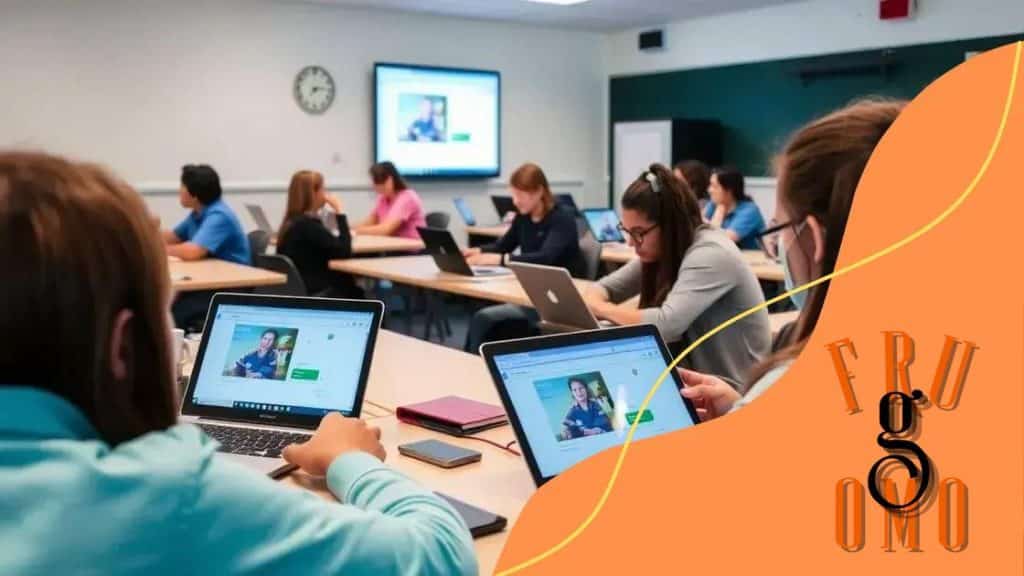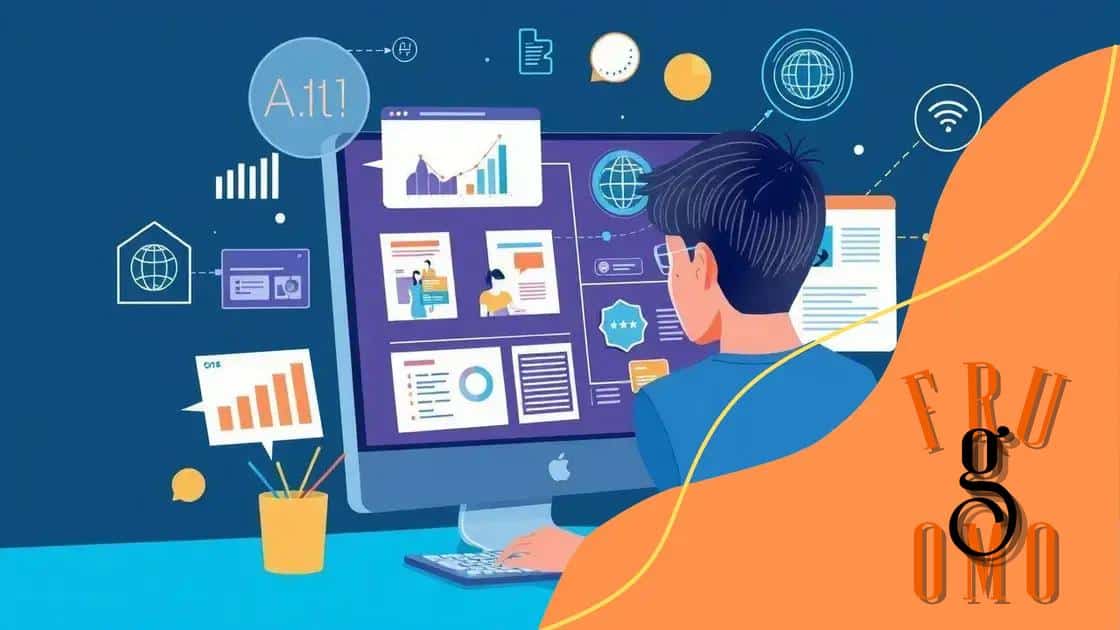Remote learning technology trends transforming education

Remote learning technology trends are transforming education by leveraging AI, virtual reality, and enhanced connectivity to create personalized, engaging, and accessible learning experiences for students.
Remote learning technology trends are changing the landscape of education, with innovations that make learning more accessible and engaging. Have you ever thought about how these advancements might impact your learning experience?
Emerging tools reshaping remote learning
Emerging tools in education are making a significant impact on the way students learn. These tools enhance engagement and accessibility, driving the remote learning revolution.
One of the key trends is the adoption of platforms that foster collaboration among students and teachers. Tools like virtual classrooms and discussion forums are becoming staples in online education. By providing interactive environments, they promote active participation and real-time feedback.
Popular Tools for Remote Learning
Many tools are leading the charge in transforming remote learning. Some noteworthy options include:
- Learning Management Systems (LMS): Platforms such as Moodle and Canvas simplify course management and content delivery.
- Video Conferencing Software: Zoom and Microsoft Teams facilitate live discussions and lectures.
- Collaboration Tools: Google Workspace and Microsoft 365 allow for seamless teamwork on projects.
Another fascinating aspect is the use of adaptive learning technologies. These systems analyze student performance and tailor content to meet individual needs. This personalization fosters better learning outcomes by addressing the unique challenges each student faces.
Benefits of Emerging Tools
Utilizing advanced educational tools brings numerous advantages:
- Increased Accessibility: Students can engage with materials anytime and anywhere.
- Enhanced Engagement: Interactive elements help maintain student interest and motivation.
- Improved Learning Outcomes: Personalization leads to more effective learning experiences.
As technology evolves, the landscape of remote learning continues to change. Embracing these tools not only enhances educational experiences but also prepares students for a future that increasingly relies on tech-driven solutions.
Benefits of hybrid learning environments
Hybrid learning environments are transforming the way students engage with education. By blending in-person and online learning, these models offer flexibility and innovation.
One major advantage of hybrid learning is that it caters to different learning styles. Students can access resources online and participate in face-to-face activities, which promotes a more personalized learning experience.
Key Advantages of Hybrid Learning
Hybrid learning brings numerous benefits to both students and educators:
- Flexibility: Students can choose when and where to study, accommodating their individual schedules.
- Enhanced Engagement: Interactive tools and varied formats keep learners interested and motivated.
- Improved Collaboration: Group projects can be conducted both in-person and online, fostering teamwork across different platforms.
Additionally, hybrid environments allow educators to use technology more effectively. Online components enable teachers to track student progress and provide timely feedback. With data analytics, they can identify areas where students may need extra support.
Support for Diverse Learners
Hybrid learning is especially beneficial for diverse student populations. It can accommodate students with different needs, such as those with disabilities or those who require a slower pace. By offering both online and in-class options, educators can ensure that every student has the opportunity to succeed.
Moreover, these environments help prepare students for the future workforce. As workplaces increasingly adopt hybrid models, students gain essential skills that will be beneficial in their careers. Communication, collaboration, and adaptability are all crucial skills developed in hybrid settings.
How AI is enhancing online education

Artificial Intelligence (AI) is playing a crucial role in enhancing online education. By integrating smart technologies, learning experiences become more engaging and efficient for students.
One major way AI improves education is through personalized learning. AI systems analyze student performance and adapt learning materials to meet individual needs. This means that no two students experience exactly the same learning path, allowing them to progress at their own pace.
AI-Powered Tools in Online Education
Several innovative tools leverage AI to enrich online learning:
- Intelligent Tutoring Systems: These systems provide customized tutoring and feedback based on a student’s unique strengths and weaknesses.
- Automated Grading: AI tools can quickly evaluate assignments and provide immediate feedback, freeing educators to focus on teaching.
- Predictive Analytics: Using data, AI can forecast student performance and suggest interventions to help keep learners on track.
Another key advantage is the enhancement of student engagement through interactive content. AI can create immersive experiences, such as virtual reality (VR) simulations, that make learning more exciting and relatable. This hands-on approach fosters active participation and retention of knowledge.
Supporting Educators with AI
AI is also assisting teachers in revolutionizing how they deliver instruction. By automating administrative tasks, educators can spend more time connecting with students. They can use AI insights to tailor their teaching strategies to better suit their students’ needs.
Moreover, AI tools can help identify students who may be struggling. By analyzing data patterns, educators can intervene early, offering personalized support to those who require it. This proactive approach helps ensure that all students have the opportunity to succeed in an online environment.
Challenges in adopting remote learning
Adopting remote learning comes with various challenges that schools and students must navigate. While the technology offers great potential, several hurdles can impact the effectiveness of this educational model.
One of the primary issues is access to technology. Not all students have reliable internet or devices at home, which can lead to disparities in learning opportunities. Overcoming this digital divide is crucial for ensuring that all students can participate fully in remote learning.
Common Challenges Faced
There are several notable challenges when shifting to remote learning:
- Engagement: Keeping students motivated in a virtual environment can be difficult. Teachers need to find ways to make online lessons interactive and engaging.
- Communication: Effective communication between teachers and students can suffer in online settings, leading to confusion and misunderstanding of tasks and expectations.
- Assessment: Evaluating student progress poses challenges since traditional testing methods may not effectively measure knowledge in an online context.
In addition, feelings of isolation can affect students. Learning remotely can be lonely, and without social interaction, students may find it hard to stay focused and engaged. Building community among remote learners is essential for their emotional well-being.
Instructor Readiness and Training
Another significant challenge lies in the preparedness of educators. Many teachers require training to effectively use digital tools. If instructors are not comfortable with technology, it can hinder their ability to teach effectively in a remote environment.
Furthermore, the lack of immediate feedback in online learning can impede students from understanding their mistakes. Without timely responses, students may struggle to grasp complex topics, leading to confusion and frustration.
Future predictions for remote education technology
The future of remote education technology looks promising and dynamic. As advancements continue, several trends indicate where education is heading.
One key prediction is the increased use of artificial intelligence (AI) in everyday learning tools. AI will help personalize the learning experience, adjusting content to fit each student’s pace and learning style. This means students will have a tailored education that meets their unique needs, making remote education even more effective.
Key Technology Trends on the Horizon
Some significant trends to watch for include:
- Enhanced Virtual Reality (VR): VR will create immersive learning experiences, allowing students to explore subjects like history or science in 3D environments.
- Cloud-Based Solutions: More institutions will rely on cloud technology to store resources and enable real-time collaboration among students and teachers.
- 5G Connectivity: Faster internet speeds will enhance online learning by accommodating more video content and interactive platforms without lag.
Moreover, the emphasis on social-emotional learning (SEL) will grow. Educational platforms will integrate tools to support students’ well-being alongside their academic success. Programs that focus on mental health and emotional skills will become common in virtual settings, creating a more holistic approach to education.
Integration of Data Analytics
Data analytics will play a significant role in improving educational outcomes. By analyzing student performance data, educators can identify trends and adjust their teaching methods accordingly. This data-driven approach will help school systems implement strategies that optimize learning for all students.
As these technologies evolve, the collaboration between educators, parents, and students will also strengthen. Communities will take an active role in creating supportive learning environments, both online and offline. This collaboration will lead to innovative educational solutions that benefit everyone involved in the learning process.
FAQ – Frequently Asked Questions about Remote Learning Technology
What are the main benefits of remote learning technology?
Remote learning technology offers flexibility, access to diverse resources, and personalized learning experiences for students.
How can AI enhance online education?
AI can analyze student performance and provide tailored recommendations, helping create personalized learning journeys.
What challenges do schools face when adopting remote learning?
Challenges include ensuring all students have access to technology, maintaining engagement, and providing effective communication.
What future trends should we expect in remote education technology?
Expect advancements like enhanced virtual reality, better connectivity with 5G, and increased use of data analytics to support effective teaching strategies.





